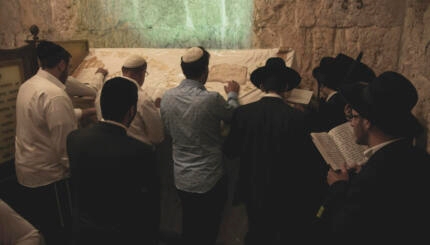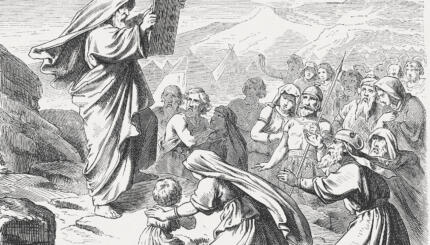Reprinted from Jewish Women in Historical Perspective, edited by Judith Baskin, 1991, with permission of the Wayne State University Press.
Jew began settling in Western Europe in Roman time, primarily as merchants and traders. As Europe became Christian, Jews found themselves subject to increasing legal disabilities, a process that continued throughout the medieval period. Eventually, Jews were barred from virtually any source of livelihood but moneylending. They were often compelled to wear distinctive clothing and badges, and ultimately, toward the end of the Middle Ages, they were either expelled altogether from areas where they had long lived ,or were forced to live in crowded and unpleasant ghettos (beginning in Rome in 1555).
The number of Jews in Western Europe was far smaller than in the Moslem world; although Western European Jews were also urban, they lived in tiny communities in cities a great deal smaller than those of the East. Despite the legal disabilities they suffered and their ultimate insecurity as to property and life, these Jews tended to be quite prosperous and enjoyed a standard of living comparable to the Christian lower nobility and upper bourgeoisie.
Married as Girls, but Economically Active
Jewish women were active participants in the family economy; and their status was certainly higher than that enjoyed by their sisters in the Islamic milieu, indicated, in part, by the large dowries they brought into marriage. Girls in this society, despite ic prohibitions to the contrary, were betrothed very young, often at the age of eight or nine. A young woman might be married at eleven or twelve, while her husband would be almost the same age.
With your help, My Jewish Learning can provide endless opportunities for learning, connection and discovery.
One young woman, an orphan whose brothers had arranged her engagement, married and established her own household while she was still eleven-and one-half years old. A year later, “when she reached her majority [according to Jewish law, twelve-and-one-half] she sued her brothers for her proper share of her father’s estate.
Early Marriage: Sin and Economics
Why were children married so young? One commentary on the Talmud from the thirteenth century gives the following explanation: “The reason we nowadays are accustomed to betroth our daughters even while they are minors is that our life in the Diaspora is becoming harder; consequently if a person is now in a financial position give his daughter a proper dowry, he is apprehensive lest after the lapse of some years he will be in no position to do so and his daughter will remain unwed forever.”
But there were other, less negative motivations as well. One would be the religious desire to remove young people from the sexual tensions and temptations that might lead to sin. Economic factors were also operative. Favorable business conditions meant that a well-dowered young couple could support themselves immediately, learning the business at the same time. Moreover, marriage could form an enduring and profitable partnership between two wealthy families, contributing to the prosperity of all. Marriages might also have a social aspect, for settling a young daughter well proved her desirability and increased her family’s prestige.
Big Dowries, High Standing
Daughters were given large portions of their parent’s property as dowries; and the size of the dowry could also enhance the social standing of the bride’s relations. Since the capital with which a young couple started life had its origin mainly in the bride’s portion, parents demanded strong guarantees in the marriage contract that the bride would be treated with respect, that her marriage would have some permanence, and that she would have financial security. Thus, the high level of dowries could assure a wife a prominent position in her household….
Monogamy and Stable Businesses
In recognition of this social reality, as well as under the influence of the prevailing mores of the Christian environment, Rabbi Gershom ben Judah (c.960-1028), the first great rabbinic authority of Ashkenazic Jewry, is credited with the ruling that polygamy (already rare in this Jewish community, although still legally permitted) was forbidden and more significantly, in opposition to rabbinic law and practice, that no woman could be divorced against her will.
Familiarity with money led many women to take the initiative in business matters, and often they supplied a part of or even the whole of the family income, sometimes allowing their husbands to devote themselves to study. During their husbands’ absences on business, women ran the families’ affairs….Women engaged in all kinds of commercial operations and occupations, but moneylending was especially preferred.
Widows would frequently continue their financial activities, occasionally in partnership with another woman. Such undertakings, which could be extremely complex, undoubtedly required literacy and training in mathematics and bookkeeping skills. Some women were probably involved in craft activities as well, and there are also some references in Christian sources to independent Jewish women who practiced medicine.
The level of religious education among Western European Jewry certainly included literacy in Hebrew for all men, and for a small elite, considerably more. Occasionally, these higher standards also applied to women, particularly those from families distinguished for their learning. In the early twelfth century one of the daughters of Rabbi Shlomo ben Isaac (Rashi), the preeminent biblical and Talmudic commentator of the Ashkenazic Middle Ages, is known to have recorded responsa (answers to legal questions) from her father’s dictation, an undertaking requiring knowledge of rabbinic Hebrew…
The intellectual roles of learned Jewish women, however, remained ancillary to mainstream “male” Judaism, consisting either of assisting the male members of their family or providing elementary instruction and synagogue leadership to young girls and other less privileged women. To call these women’s activities ancillary of course, is not to invalidate their spiritual depth and religious meaning for the participants…
Since most ordinary Jewish women were cut off from the knowledge of Hebrew that would enable them to read the traditional liturgy and holy books, during the Middle Ages, a separate women’s vernacular literature of tekhines (supplicatory prayers specially directed towards women’s needs and concerns) began to be produced—sometimes by women—and simplified “women’s Bibles” to fill women’s spiritual needs were written. These volumes had great appeal for less-educated male members of the Jewish community as well.
tml>


